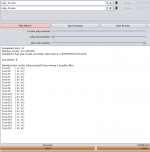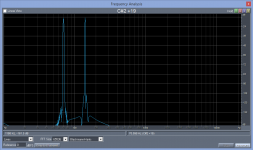People might try this one first. It's a 70Hz sine with 100% H2. Actually, it's a slightly stretched harmonic that is at 140.5Hz, not 140.0Hz. The 0.5Hz offset gives a 2 seconds repetition rate of the phase of the harmonic slowly and continuosly rotating through 360°. So, regardless of the speaker's phase response there will always a section of that loop where the harmonic is in-phase and another where it is exactly out-of-phase.
If we were insensitive to phase shift (actually, to the waveform changes introduced by that) the whole thing would sound excatly the same all the time no matter what the phase relation is, but.... well, listen for yourself...
Yes- I can hear a variation.
//
Perhaps we could use actual music samples in the tests?There has been a realization in psychoacoustic research that test signals need to be more realistic & complex rather than the simplistic tones used in the past
Perhaps we could use actual music samples in the tests?
That's difficult as most experiments are examining a single dimension & there are a lot of dynamic multi-dimensional changes in music - difficult to account for these variables in analyzing results - it's pretty mach the same for technical measurements, music is almost never used as test signal
Yes- I can hear a variation.
//
Me too, just, on headphones. I confidently conclude that if it was 1% I wouldn't.
I confidently conclude that if it was 1% I wouldn't.
And that is the point. We cannot compare incomparable.
Attachments
Last edited:
It was used here, but you would not call this test technical. I have certainly used it to measure if a stream is bit perfect and also to measure the frequency response of the signal chain and of loudspeakers.- it's pretty mach the same for technical measurements, music is almost never used as test signal
Admittedly more difficult with distortion effects. But IIRC AP can now do it. (I'd have to confirm that)
Isn't that one of the points being made by Jakob & I - multidimensional perceptual testing (music) is very difficult to get right - why do you think that a sine wav signal is more effective for some forms of audibility testing (ABX, spot the difference testing) rather than music signal? It's not just down to the possibility of masking - it's got to do with the workings of auditory perception - we only need to focus on a single static sound with no other sounds confusing or perception & we are not trying to focus on a single sound within a soundscape of dynamically changing soundsIt was used here, but you would not call this test technical.
Yep, there are some specific circumstances/tests that can use music signals but do you test speaker freq response with a real music signal?I have certainly used it to measure if a stream is bit perfect and also to measure the frequency response of the signal chain and of loudspeakers.
Interested to hear about the AP tests using music - certainly multitone signals but that's not musicAdmittedly more difficult with distortion effects. But IIRC AP can now do it. (I'd have to confirm that)
Last edited:
If that's one of your points, then you've missed the whole point of the tests in this thread. But that's been said before.Isn't that one of the points being made by Jakob & I (sic) - multidimensional perceptual testing (music) is very difficult to get right
I have. And DACs, preamps, line amps, valve amps, crossovers. It's more labor intensive than using sine sweeps or noise, but acts as a sort of sanity check and verification. You know, for all those people who say things like "tests signals aren't the same as real music." 😉do you test speaker freq response with a real music signal?
A great example of irony - you try to accuse me of exactly what you demonstrate by this commentIf that's one of your points, then you've missed the whole point of the tests in this thread. But that's been said before.
Do you know what was distorting?First I could not do this either and was really confused. Then I picked up on used level. I was playing it to loud. Then it was easy.
//
I don't think that word means what you think it means. 😉A great example of irony - you try to accuse me of exactly what you demonstrate by this comment
an off-line test for the public forum, but even as such it is helpful and interesting to me
Hi Pavel,
I believe that it is more useful to you because mostly you can hear the difference. Reading people's conclusion (that might be right or wrong) is different from listening and experiencing by your own ears.
Once you can hear it, then the next step is to be able to decide whether A is better than B, or not... 😉
Seems that not very many members of this forum are interested in the audible effect of phase coherence of audio reproduction chain, even less are those interested in phase of the harmonic distortion. 🙂
In my experience, it is very important, especially when everybody else think that it is not so they ignore it in a design and it becomes a 'make or break'.
In the recent test by KSTR I think the only difference between original file and a file going through A-D-A conversion is the phase (?). Pavel could hear the difference between the two files but I believe it is hard to decide which one is better, unless one learn from other experiences such as why the 'thin' sound of original file should be better than the 'detailed and transparent' sound of distorted file.
All of amplifiers that I currently use has phase response difference of 10° - 25° between 1kHz and 20kHz. I suspect some difference in spatial information of the presentation, but has not yet arrived at a definite conclusion. Perhaps I will be able to get better understanding once I have an amplifier with less than 1° phase response difference between 1kHz and 20kHz.In my experience, it is very important, especially when everybody else think that it is not so they ignore it in a design and it becomes a 'make or break'.
In the recent test by KSTR I think the only difference between original file and a file going through A-D-A conversion is the phase (?). Pavel could hear the difference between the two files ...
However, I found the spatial depth effect of negative 90° 2H is easier to perceive with the caveat of what Nelson Pass mentioned about not everyone being able to hear or care about the effect. I hope that other members with experience and trained hearing like Pavel would be interested to look and comment about the effect to advance the understanding a bit further. I would not be surprised if further investigation reveals other explanation or even found the relevant correlation to be something else.
All of amplifiers that I currently use has phase response difference of 10° - 25° between 1kHz and 20kHz.
I don't think this kind of phase critical. This one is mostly the result of wideband output transistor, correct?
Do you know what was distorting?
My ears most probably. But I will try my DAC/HP amp instead of the laptop one day.
//
All of amplifiers that I currently use has phase response difference of 10° - 25° between 1kHz and 20kHz. I suspect some difference in spatial information of the presentation, but has not yet arrived at a definite conclusion. Perhaps I will be able to get better understanding once I have an amplifier with less than 1° phase response difference between 1kHz and 20kHz.
However, I found the spatial depth effect of negative 90° 2H is easier to perceive with the caveat of what Nelson Pass mentioned about not everyone being able to hear or care about the effect. I hope that other members with experience and trained hearing like Pavel would be interested to look and comment about the effect to advance the understanding a bit further. I would not be surprised if further investigation reveals other explanation or even found the relevant correlation to be something else.
Don't bother if don't have very special speakers. Also, this was a varying phase change - that you will not have in an amp.
//
The example here with H2 at 100% and same amplitude as base frequency is an extreme. I doubt that after reducing H2 to 0.7% max. as in the fruit test the phase change of H2 would be audible. And it is not changing in the amplifier under test, as TNT has correctly stated.
I did a phase test recently, anyone interested may try again.
Audibility of allpass phase distortion (test)
I did a phase test recently, anyone interested may try again.
Audibility of allpass phase distortion (test)
- Home
- General Interest
- Everything Else
- Can you tell original file from tube amp record? - test

